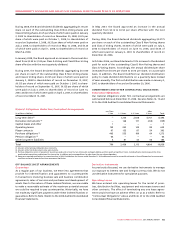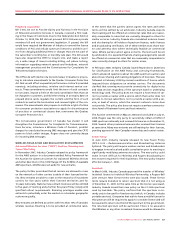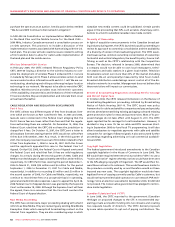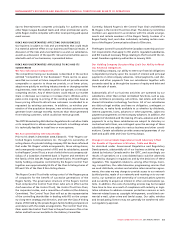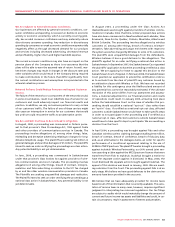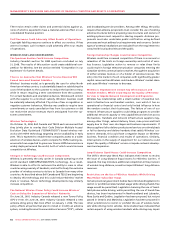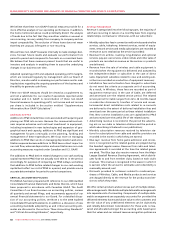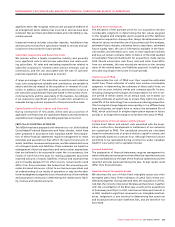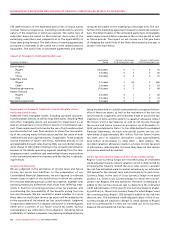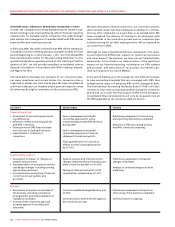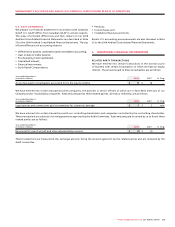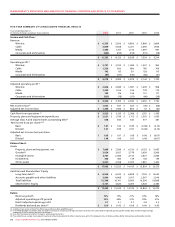Rogers 2008 Annual Report Download - page 68
Download and view the complete annual report
Please find page 68 of the 2008 Rogers annual report below. You can navigate through the pages in the report by either clicking on the pages listed below, or by using the keyword search tool below to find specific information within the annual report.
64 ROGERS COMMUNICATIONS INC. 2008 ANNUAL REPORT
MANAGEMENT’S DISCUSSION AND ANALYSIS OF FINANCIAL CONDITION AND RESULTS OF OPERATIONS
and broadcasting service providers. Among other things, the policy
requires that antenna proponents must consider the use of existing
antenna structures before proposing new structures and owners of
existing systems must respond to sharing requests. Antenna pro-
ponents must also undertake public notification using defined
processes and must address local requirements and concerns. Certain
types of antenna installations are excluded from the requirement to
consult with local authorities and the public.
Foreign Ownership Changes Could Increase Competition.
Wireless could face increased competition if there is a removal or
relaxation of the limits on foreign ownership and control of wire-
less licences. Legislative action to remove or relax these limits
could result in foreign telecommunication companies entering the
Canadian wireless communications market, through the acquisition
of either wireless licences or of a holder of wireless licences. The
entry into the market of such companies with significantly greater
capital resources than Wireless could reduce Wireless’ market share
and cause Wireless’ revenues to decrease.
Wireless is Dependent on Cer tain Key Infrastructure and
Handset Vendors, Which Could Impact the Quality of Wireless’
Services or Impede Network Development and Expansion.
Wireless has relationships with a small number of essential net-
work infrastructure and handset vendors, over which it has no
operational or financial control and only limited influence in how
the vendors conduct their businesses. The failure of one of our
network infrastructure suppliers could delay programs to provide
additional network capacity or new capabilities and services across
the business. Handsets and network infrastructure suppliers may,
among other things, extend delivery times, raise prices and limit
supply due to their own shortages and business requirements. If
these suppliers fail to deliver products and services on a timely basis
or fail to develop and deliver handsets that satisfy Wireless’ cus-
tomers’ demands, this could have a negative impact on Wireless’
business, financial condition and results of operations. Similarly,
interruptions in the supply of equipment for our networks could
impact the quality of Wireless’ service or impede network develop-
ment and expansion.
Long-Distance Equal Access Could Increase Competition.
The CRTC’s three-year Work Plan indicates their intent to review
the issue of Long-Distance Equal Access for Wireless Carriers. If
required, this may introduce additional competition in the provision
of wireless long-distance, as well as impact Wireless’ long-distance
revenues.
Restrictions on the Use of Wireless Handsets While Driving
May Reduce Subscriber Usage.
Certain provincial government bodies have introduced legislation to
restrict or prohibit wireless handset usage while driving (hands-free
usage would be permitted). Legislation banning the use of hand-
held phones while driving, while permitting the use of hands-free
devices, has been implemented in Newfoundland and Labrador,
Nova Scotia and Québec. Legislation has been proposed, but not yet
passed in Ontario and Manitoba. Legislation has been proposed in
other jurisdictions to restrict or prohibit the use of wireless hand-
sets while driving motor vehicles. Some studies have indicated that
certain aspects of using wireless handsets while driving may impair
There exist certain other claims and potential claims against us,
none of which is expected to have a material adverse effect on our
consolidated financial position.
Tariff Increases Could Adversely Affect Results of Operations.
Copyright liability pressures continue to affect our services. If fees
were to increase, such increases could adversely affect our results
of operations.
WIRELESS RISKS AND UNCERTAINTIES
The Spectrum Auction Could Increase Competition.
Industry Canada’s auction for AWS spectrum concluded on July
21, 2008. The results of this auction could create additional com-
petition for Wireless. See the section entitled “Competition in our
Businesses” for further details.
There is no Guarantee that Wireless’ Service Revenue Will
Exceed Increased Handset Subsidies.
Wireless’ business model, as is generally the case for other North
American wireless carriers, is substantially based on subsidizing the
cost of the handset to the customer to reduce the barrier to entry,
while in return requiring a term commitment from the customer.
For certain handsets and smartphone devices, Wireless will commit
with the supplier to a minimum subsidy. Wireless’ business could
be materially adversely affected if by virtue of law or regulation or
negative customer behaviour, Wireless was unable to require term
commitments or early cancellation fees from its customers or did
not receive the service revenues that it anticipated from the cus-
tomer commitment.
Wireless Technologies.
On October 10, 2008, Bell Canada and TELUS each announced that
they jointly plan to overlay their Code Division Multiple Access/
Evolution Data Optimized (“CDMA/EVDO”) based wireless net-
works with HSPA technology targeting service availability in early
2010. This is expected to enable these companies access to a wider
selection of wireless devices, and to compete for HSPA roaming rev-
enues which are expected to grow over time as HSPA becomes more
widely deployed around the world, both of which would increase
competition at Wireless.
Changes in Technology Could Increase Competition.
Wireless is presently the only carrier in Canada operating on the
world standard GSM/GPRS/EDGE/HSPA technology. As a result,
Wireless is able to offer its customers the ability to roam in other
countries using a variety of handsets, and is effectively the exclusive
provider of wireless services to visitors to Canada from many other
countries. As described above Bell Canada and TELUS are beginning
to deploy this technology and this could reduce Wireless’ market
share or revenue. Future technology developments may similarly
increase competition.
The National Wireless Tower Policy Could Increase Wireless’
Costs or Delay the Expansion of Wireless’ Networks.
On June 28, 2007, Industry Canada released a new Tower Policy
(CPC-2-0-03). On June 28, 2007, Industry Canada released a new
antenna siting policy that took effect on January 1, 2008. The new
policy affects all parties that plan to install or modify an antenna
system, including Personal Communications Services (“PCS”), cellular



